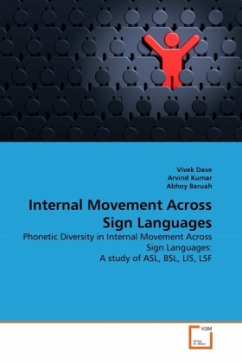To analyze internal movement, I developed an anatomical classification system based on combinations of possible joints and muscle contractions resulting in movement of the hand, which maintains its same absolute location in the signing space. Using this coding system, I mapped the frequency of internal movement types across a language's set of internal movement signs. These results allowed me to speculate on the properties of the articulator that most readily allow sign languages to change or innovate. In addition, I looked at the prevalence of marked and unmarked hand configurations and how markedness correlates to their appearance within a given language. Overall, both language specific and universal trends emerge. Based on observations from the data, I propose a few universal tendencies: the Distal Joint Limitation, the Proximal Joint Preference, the Immobile Base Limitation, and the Internal Movement Weak Reduction. This thesis provides an alternative system of viewing internal movement, as well as a sign perspective for the phonetic diversity across languages.
Bitte wählen Sie Ihr Anliegen aus.
Rechnungen
Retourenschein anfordern
Bestellstatus
Storno








